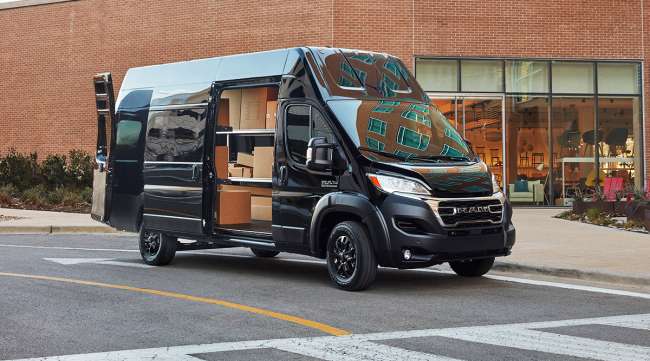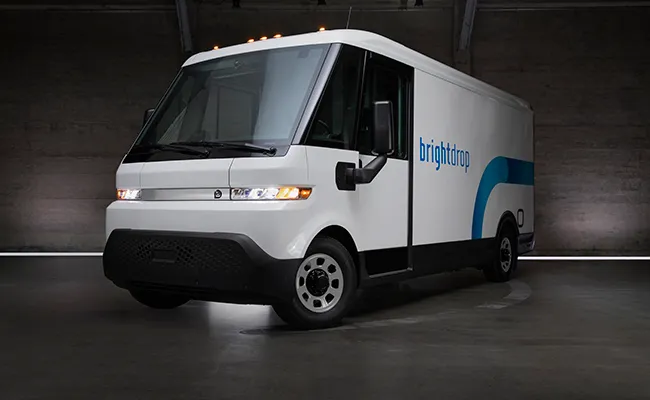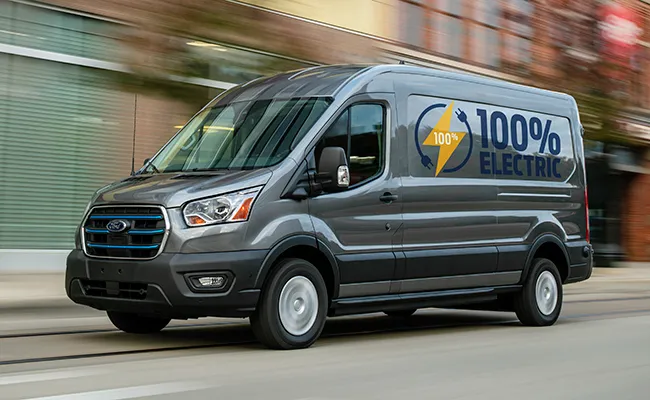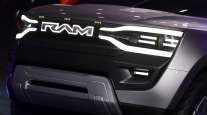The Detroit News
Stellantis’ Goal: Become No. 1 in Light Commercial Vehicles

[Stay on top of transportation news: Get TTNews in your inbox.]
The maker of Ram, Jeep, Dodge and Chrysler vehicles has set its sights on becoming the world’s top light-commercial vehicle company, but it’s going to face some major obstacles to get there, experts say.
Seeking to double its revenues by 2030 to more than $320 billion, Stellantis has identified commercial vehicles as one of seven accretive business units. Other automakers, however, also are emphasizing the market: General Motors Co. launched the BrightDrop electric commercial van brand in 2021, and Ford Motor Co. — the leader in North America and Europe last year in LCVs, according to consultant Mordor Intelligence LP — has made its Ford Pro business a key piece of its growth strategy.
“For all three companies, these aren’t vehicles for fun,” said Stephanie Brinley, principal automotive analyst for the Americas at S&P Global Inc. “They’re something to the effect of the lifeblood of the company. We need these companies to get work done: to move transit, to keep the power on, to get the goods where they need to go, to get you when you need to get to the hospital. It’s not an understatement of what those vehicles are to our lives.”
That makes these commercial customers desirable. Plus, they’re likely early adopters as automakers face more stringent carbon-emission regulations. Delivery vans often are on consistent routes that reduce range anxiety risks. All-electric models can save on fuel costs.
Stellantis, which already sells electric and hydrogen fuel cell-powered vans in Europe, will launch an electric Ram ProMaster commercial van in Mexico late this year as its first full EV in North America. Ford launched its electric E-Transit van last year. GM began production of the BrightDrop Zevo 600 in December, with the smaller Zevo 400 expected later this year.

GM's BrightDrop Zevo 600 is an all-purpose, all-electric walk-in van. (gobrightdrop.com)
Although electrification and other new technologies like data telematics and software represent a shakeup and present the potential for opportunity to capture market share, commercial customers tend to be fiercely brand-loyal. Additionally, Stellantis would need more production capacity to support leadership volumes in North America.
“Toppling Ford would be a big feat for anybody, especially No. 3,” said Sam Fiorani, vice president of global vehicle forecasting for AutoForecast Solutions, about Stellantis’ ambitions. “There’s a 2-to-1 advantage on the Transit to the ProMaster in the U.S. The F-series is also 2-to-1 over the Ram. That’s a huge hurdle to jump.”

The Ford E-Transit Van made its debut in 2022. (ford.com)
The automaker declined an interview request to discuss how it plans to achieve its LCV goals, though The Detroit News spoke last week with Chief Software Officer Yves Bonnefont on the role software will play in that. Last year when announcing the automaker’s Dare Forward 2030 strategy, CEO Carlos Tavares said there will be 26 commercial launches globally by 2030, when Stellantis will have doubled LCV revenues with 40% all-electric sales. The presentation suggested Stellantis would hold a No. 1 “position” for commercial vehicles in North America by 2024.
Rental companies, governments and businesses make up fleet sales. They include upfitters like Winnebago Industries Inc., from whom Robyn Eller, 53, of Washington, Md., recently bought a new Travato, a camper van built in a high-roof Ram ProMaster. It has made her camping experience better by not having to hook up a trailer, she said.
“I liked the styling of it better than the Ford Transit or the (Mercedes-Benz) Sprinter,” Eller said of the $134,000 purchase. “It’s comfortable to drive. It’s pretty good on gas. I feel like I’m escaping the day-to-day stresses.”
Stellantis wants to become world's top light-commercial vehicle company https://t.co/91QD17TXEy — The Detroit News (@detroitnews) June 3, 2023
Stellantis’ U.S. fleet sales rose 67% year-over-year in the first quarter of 2023 with Ram posting a record for fleet sales for the first three months of the year. That was achieved despite a stop-sale for part of the quarter on heavy-duty trucks because of a fire-risk recall.
Automakers often resort to the fleet channel when they have an abundance of inventory, and Stellantis has more than 100 days of supply, said Michelle Krebs, executive analyst for auto information resource Cox Automotive Inc. It’s an area that had been pushed aside in favor of retail sales amid the global microchip shortage, but people are traveling again, so rental companies are purchasing to make up for what they unloaded when business slowed from the COVID-19 pandemic.
“Stellantis is still being restrained on incentives,” she said. “They may be offering some, but they are really going after profit per vehicle.”
Richard Palmer, Stellantis’ chief financial officer, said last month during a financial results call that the company felt comfortable with inventory levels in North America, though adjustments still were being made to the mix of vehicles available.
“All our commercial vehicle businesses are extremely strong, and we’re in a relatively similar position to Ford and fighting it out with them,” he said. “But global leadership in LCV, obviously, the strength that we have, and they have are slightly different. They have a very big position in pickup in North America. We are smaller than them, but we’ve been improving that over the last decade, so getting closer to them, and I think our new products will continue to help us to be very competitive in that area. And obviously, in Europe, and in South America, we have very strong positions on LCV.”
A representative for Ford Pro declined to comment on Palmer’s statement and Stellantis’ ambitions.
Challenges of Fleet Sales
Automakers themselves direct large fleet purchases, such as those to major rental companies. That makes existing relationships valuable, experts said. Stellantis’ electric ProMaster garnered attention with the announcement last year that Amazon.com Inc. will add thousands of the vans to its fleet annually under a multiyear agreement toward its carbon-neutral goal.
In addition to salespeople relationships, fleet owners, drivers and on-site mechanics have the equipment, parts and knowledge that often make them most comfortable with a particular brand, making them less likely to switch, Fiorani said.

Hayden Cardiff, co-founder and chief innovation officer of Idelic, discusses predictive analytics software and scoring driver practices. Tune in above or by going to RoadSigns.ttnews.com.
Ram, though, has jolted the sector before. A more muscular 1500 pickup in the ’90s set the stage for it to be a major player, and its spinoff from Dodge in 2009 as the “Built to Serve” work brand today has propelled its growth, allowing it to compete with the Chevrolet Silverado’s U.S. volumes. The all-electric Ram 1500 REV that will launch late next year makes due on its commitment to outperform its peers in payload, charging speed, range and other key metrics, according to Ram’s figures.
Still, to produce at the level Stellantis is suggesting, it would need more production space. Ram CEO Mike Koval Jr. told The News earlier this year that the company is investing $200 million in the Saltillo Van Assembly Plant in Mexico to expand capacity for both gas-powered and electric ProMasters. That’s expected to be completed at the end of 2024.
“Ford can build more than Stellantis can,” Brinley said. “To say they would outsell overall might be a tall order.”
Koval said the company had considered importing vans made in Europe to North America before the investment decision was made. He’s also suggested Ram is looking at a replacement for the discontinued smaller ProMaster City.
Stellantis indefinitely idled the former Jeep Cherokee plant in Belvidere, Ill., ahead of contract negotiations with the United Auto Workers this summer. Analysts like Fiorani have suggested the automaker could build the REV there if it expects to have the volumes, though the timeline to make that decision is shrinking quickly. Meanwhile, Stellantis has been working with potential launch teams from the Sterling Heights, Mich., and Warren, Mich., truck assembly plants where autoworkers currently build 1500s.
Want more news? Listen to today's daily briefing above or go here for more info
As automakers make the transition, battery technology and its cost will play an important role in the competitiveness of their offerings since batteries can represent 40% or more of the cost of an EV, said Ferdinand Dudenhöffer, director of the Center Automotive Research in Duisburg, Germany.
“You have to find ways to make batteries cheaper and more competitive,” he said. “Stellantis invested three years ago in a manufacturing site of batteries. They aren’t just dependent on the battery manufacturer.”
Stellantis this week celebrated the inauguration of its first battery plant, which is in Billy-Berclau Douvrin, France, through its joint venture with TotalEnergie SE and the Mercedes-Benz Group, Automotive Cells Co. It also has invested in startups for lithium-sulfur and solid-state batteries.
For now, the gas-powered commercial vans available continue to sell at a “brisk” pace, dealers say, and supply remains constrained.
“We don’t get as many ProMasters as we’d like,” said Bill Golling, president of three CDJR dealerships in southeast Michigan, among others, of the full-size vans that start at $41,635. “Plumbers and carpenters and all of that are looking for them.”
Jim Walen, owner of CDJR of Seattle, says most of the vans are already sold by the time the delivery truck arrives at the showroom. Buyers are looking for electrified options, he noted, though he doesn’t expect to see the electric ProMasters until the middle or end of next year after Amazon gets its deliveries.
“I’m proud to represent the brand that has that relationship with Amazon,” he said. “There’ll be a halo effect swivel with the Amazon partnership. It’s a big order. That’ll mean strong demand for our vehicles and lots of sales for us in the not-distant future.”
Amazon.com Inc. ranks No. 19 on the Transport Topics Top 100 list of the largest private carriers in North America.
Software’s Advantages
An increasingly valuable element of managing fleets is data and connectivity that can allow managers to know where vehicles are, maintain them and communicate with drivers, said Bonnefont, Stellantis’ software chief. Those types of needs make a software LCV suite of services that Stellantis is developing a good fit.
The automaker next year will begin rolling out its new software platforms that will simplify a vehicle’s electric architecture, allow more of the vehicle to be updated over-the-air, offer an AI-backed cockpit and support more advanced automated driving. It’s, however, also looking for opportunities to update vehicles on the road already, Bonnefont said. Priorities include rerouting vehicles and correcting driving.

Bonnefont
“It is a very classical, you manage your fleet, and you have to reroute,” Bonnefont said. “Instead of making phone calls to your drivers, you just find a convenient way to deliver information in the vehicle that is interacting with the driver.
“The other area we see a lot of transaction is everything that relates to the behavior on the roads. Companies want their fleets to be perceived as not having dangerous behaviors on the road, so you want to be able to support the policies in terms of safety and appropriate behaviors of the drivers on the road. There are many things we can do for that to help coach people and help them to understand the behaviors that are great ones, and which ones should not be encouraged.”
Ford has been developing telematics for more than a decade alongside other competitors. But Bonnefont believes Stellantis’ new software platforms will be leading in the space because of the automaker’s global volumes and how it will unite new vehicles to be updated altogether under a simplified system.
The access to the kind of information offered by these platforms is valuable to the customers these automakers service, Brinley said.
“It’s profits at the end of the day,” she said. “If you behave in one manner that makes your vehicle last longer, that is how your company works and makes money and improves on time.”
Distributed by Tribune Content Agency, LLC




